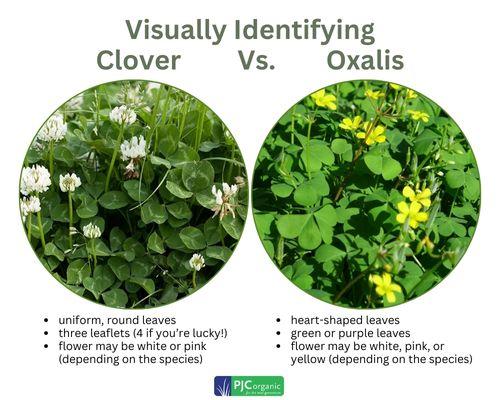First, Clover, Oxalis, and Black Medic are three common summer weeds that are often misidentified. Although these weeds can all be confused for one another—and are all found in nutrient deficient soils—it’s critical to identify differences as they indicate different soil characteristics. Therefore, read about their characteristics, causes, and treatments to properly address the weeds in your lawns or athletic fields.
Clover — Indicative of Low pH and Low Fertility
Characteristics of clover:
- rapid spreader
- Thrives in soils with low pH (which is also an indicator of low fertility for turf grass)
- rounded leaves that distinguish it from black medic and oxalis.
Notably, we need to clarify that clover is not classified as a “weed” by all. This nitrogen-fixing plant provides bioavailable nitrogen to turf grass. Although, it can be problematic for athletic fields. On athletic fields, the presence of clover compromises the integrity of the playing surface. While this pollinating plant may be just fine on a homeowner lawn, it doesn’t allow for consistent ball rolling speed or cleat traction when changing direction. Be sure to heavily overseed to keep playing surfaces consistent and safe. In addition, visit our blog, “Control Clover All-Naturally in Your Lawn”, for more info on clover causes and treatment.
Oxalis (aka Wood Sorrel) — Indicative of High pH
Characteristics of oxalis:
- a common perennial weed found in soils with a high pH
- heart shaped leaf structure
- trifoliate leaves
- has a bright, 5 petaled, yellow flower
Notably, with the presence of oxalis, you likely need to add sulfur to your program. Therefore, confirm your soil’s needs with a soil test.

Black Medic — Indicative of Nutrient Deficient Soil
Characteristics of black medic:
- summer annual
- legume – meaning it has the ability to ‘fix’ nitrogen (which is why it is capable of out competing turf in nutrient deficient soils).
- has a deep central tap root that keeps is well anchored and established
- can thrive in dry soils
- tear drop leaf shape
- flowers form yellow clusters that are replaced with black seed pods as it reaches reproductive maturity.
If you’re seeing a high volume of black medic, you likely need to include more PJC ProHealthy Turf fertilizers into your program.
In conclusion, there are ways to treat these weeds all-naturally. If you want further assistance developing an organic turf care program…contact us!
Interested in more info on controlling weeds all-naturally? Check out our latest blogs:
